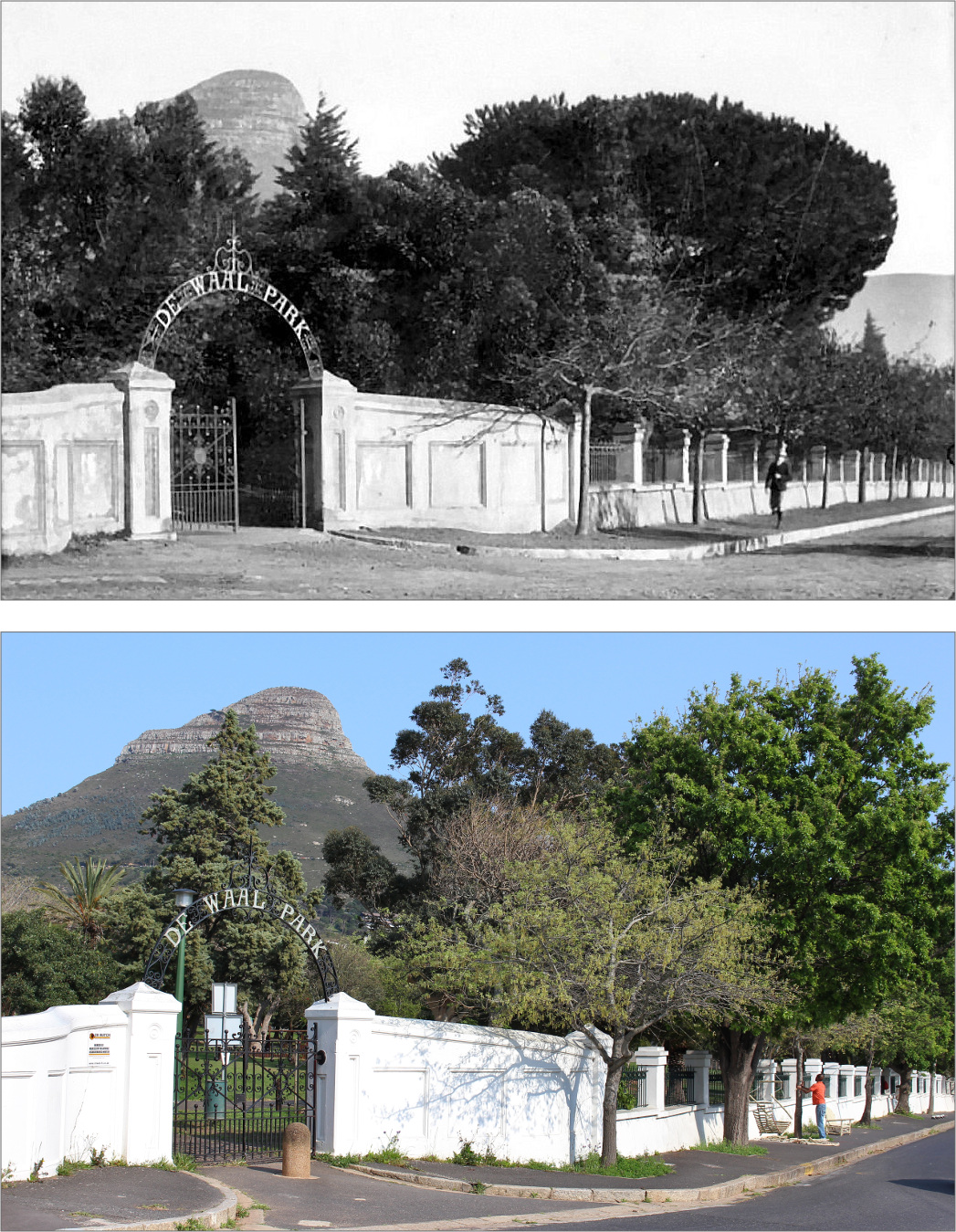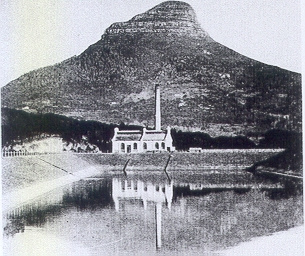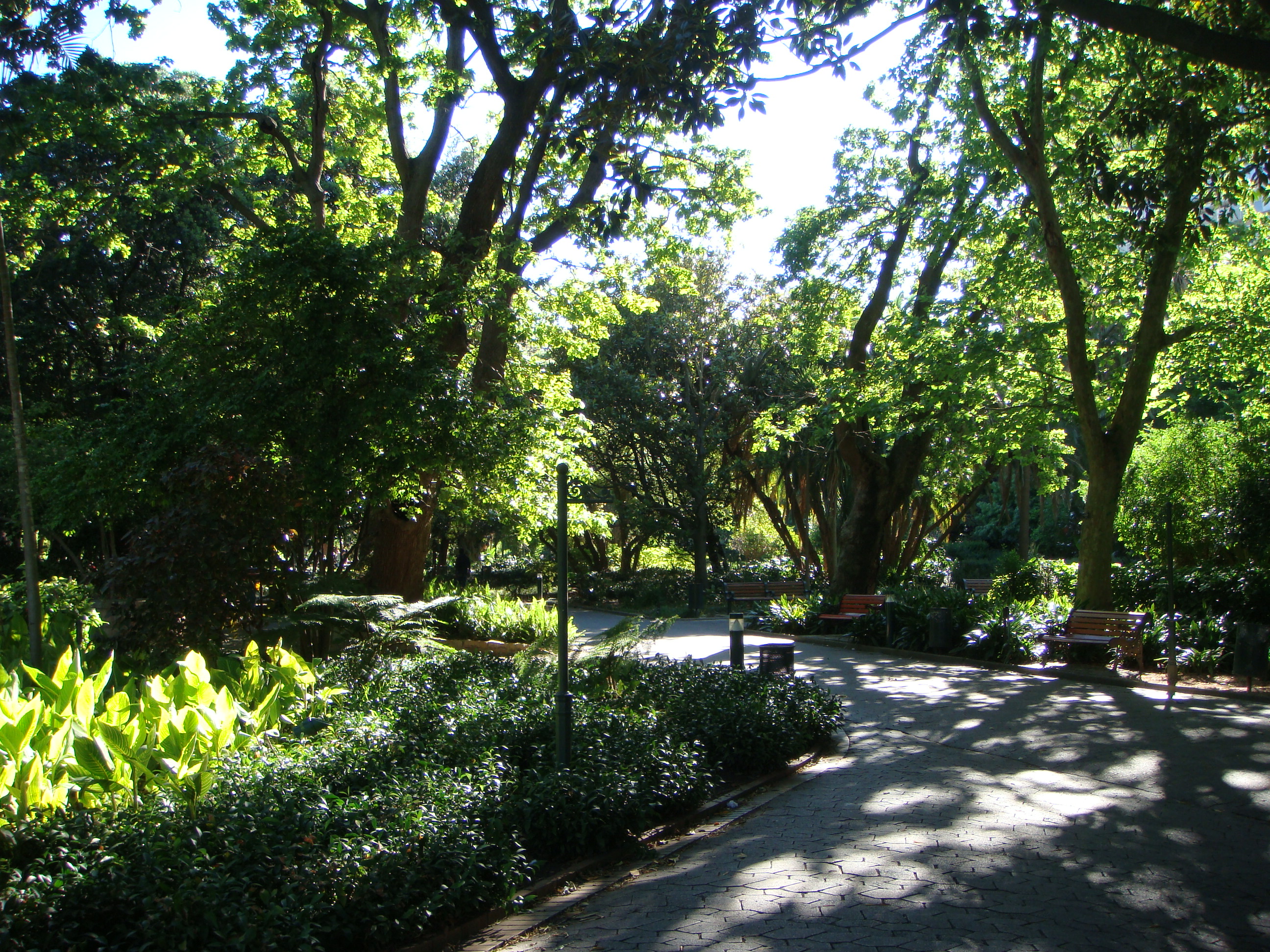|
De Waal Park
De Waal Park is a public park and heritage site in the Oranjezicht suburb of Cape Town. The park, which contains over 120 species of trees, is popular with dog walkers. The park is roughly rectangular. Molteno Dam borders the park to the south, with the other three sides bordered by roads. There are four tennis courts belonging to the Gardens Tennis Club in the South West corner. In summer, the park hosts free outdoor concerts on Sunday afternoons. History De Waal Park was Cape Town's first and largest public park, after the Company's Gardens, when it was opened in 1895. In 1877 the City Council of Cape Town purchased land from the Van Breda family who owned the farm Oranjezigt. They divided the land into three parts, first building the two smaller reservoirs below Camp Street and then building the Molteno Reservoir below Belvedere Road which also provided the city with electricity. The land in between formed a natural park. David Christiaan de Waal, who was the city coun ... [...More Info...] [...Related Items...] OR: [Wikipedia] [Google] [Baidu] |
Urban Park
An urban park or metropolitan park, also known as a municipal park (North America) or a public park, public open space, or municipal gardens ( UK), is a park in cities and other incorporated places that offer recreation and green space to residents of, and visitors to, the municipality. The design, operation, and maintenance is usually done by government agencies, typically on the local level, but may occasionally be contracted out to a park conservancy, "friends of" group, or private sector company. Common features of municipal parks include playgrounds, gardens, hiking, running and fitness trails or paths, bridle paths, sports fields and courts, public restrooms, boat ramps, and/or picnic facilities, depending on the budget and natural features available. Park advocates claim that having parks near urban residents, including within a 10-minute walk, provide multiple benefits. History A park is an area of open space provided for recreational use, usually owned and maintain ... [...More Info...] [...Related Items...] OR: [Wikipedia] [Google] [Baidu] |
Oranjezicht
Oranjezicht (Dutch: ''orange view'') is a suburb in Cape Town, South Africa, built on the site of the old Oranjezicht farm, which used to stretch at least as far as the Mount Nelson Hotel and supplied the Castle of Good Hope with fresh produce. In 1708, Nicolaus Laubscher (1651–1721), who had immigrated in the 1670s from the Swiss canton of Fribourg, bought a property on the slopes of Table Mountain that he called "Oranjezicht" because of the good view from there of the Oranje (Orange) bastion of the Castle. Subsequent to his death, the farm was evidently acquired by Pieter van Breda (1696–1759), who arrived at the Cape in 1719 from the Netherlands. "Oranjezicht" was a farm for the next two centuries. Some of the buildings of the farm as well as the old slave bell are still at the location where the farm once stood. The farmhouse was on the property directly to the east of what is now a public park and playground. It was torn down in the 1960s to make way for a bowling gre ... [...More Info...] [...Related Items...] OR: [Wikipedia] [Google] [Baidu] |
Cape Town
Cape Town ( af, Kaapstad; , xh, iKapa) is one of South Africa's three capital cities, serving as the seat of the Parliament of South Africa. It is the legislative capital of the country, the oldest city in the country, and the second largest (after Johannesburg). Colloquially named the ''Mother City'', it is the largest city of the Western Cape province, and is managed by the City of Cape Town metropolitan municipality. The other two capitals are Pretoria, the executive capital, located in Gauteng, where the Presidency is based, and Bloemfontein, the judicial capital in the Free State, where the Supreme Court of Appeal is located. Cape Town is ranked as a Beta world city by the Globalization and World Cities Research Network. The city is known for its harbour, for its natural setting in the Cape Floristic Region, and for landmarks such as Table Mountain and Cape Point. Cape Town is home to 66% of the Western Cape's population. In 2014, Cape Town was named the best place ... [...More Info...] [...Related Items...] OR: [Wikipedia] [Google] [Baidu] |
South Africa
South Africa, officially the Republic of South Africa (RSA), is the southernmost country in Africa. It is bounded to the south by of coastline that stretch along the South Atlantic and Indian Oceans; to the north by the neighbouring countries of Namibia, Botswana, and Zimbabwe; and to the east and northeast by Mozambique and Eswatini. It also completely enclaves the country Lesotho. It is the southernmost country on the mainland of the Old World, and the second-most populous country located entirely south of the equator, after Tanzania. South Africa is a biodiversity hotspot, with unique biomes, plant and animal life. With over 60 million people, the country is the world's 24th-most populous nation and covers an area of . South Africa has three capital cities, with the executive, judicial and legislative branches of government based in Pretoria, Bloemfontein, and Cape Town respectively. The largest city is Johannesburg. About 80% of the population are Black South Afri ... [...More Info...] [...Related Items...] OR: [Wikipedia] [Google] [Baidu] |
City Of Cape Town
The City of Cape Town ( af, Stad Kaapstad; xh, IsiXeko saseKapa) is the metropolitan municipality which governs the city of Cape Town, South Africa and its suburbs and exurbs. As of the 2011 census, it had a population of 3,740,026. The remote Prince Edward Islands are deemed to be part of the City of Cape Town, specifically of ward 115. Cllr. Ian McMahon is the current ward councilor of ward 115. History Cape Town first received local self-government in 1839, with the promulgation of a municipal ordinance by the government of the Cape Colony. When it was created, the Cape Town municipality governed only the central part of the city known as the City Bowl, and as the city expanded, new suburbs became new municipalities, until by 1902 there were 10 separate municipalities in the Cape Peninsula. During the 20th century, many of the inner suburban municipalities became unsustainable; in 1913 the first major unification took place when the municipalities of Cape Town, Green Po ... [...More Info...] [...Related Items...] OR: [Wikipedia] [Google] [Baidu] |
Molteno Dam
Molteno Dam is a small but historic dam, on the lower slopes of Table Mountain in Western Cape, South Africa. Still in service, it was established in 1877 and is now located in the suburb of Oranjezicht, Cape Town. Background and construction In earlier days, the infant settlement of Cape Town had been supplied with water from Table Mountain by way of canals or ''"grachts"'' (such as Buitengracht, Kaizergracht and Heerengracht - now major streets). When these canals had to be covered due to public health concerns, the elders of the city agreed on the need to build a dam up on the Table Mountain slope above the growing city, to store water from the mountain's springs. This water would otherwise have flowed directly into the sea - a shameful waste in the eyes of the city's administrators. By the late 1860s, Cape Town was also facing severe water restrictions, partly due to its expanding population. The dam's actual construction was part of a huge expansion of infrastructure that ... [...More Info...] [...Related Items...] OR: [Wikipedia] [Google] [Baidu] |
Company's Gardens
The Company's Garden is the oldest garden in South Africa, a park and heritage site located in central Cape Town. The garden was originally created in the 1650s by the region's first European settlers and provided fertile ground to grow fresh produce to replenish ships rounding the Cape. It is watered from the Molteno Dam, which uses water from the springs on the lower slopes of Table Mountain. History The Dutch East India Company The United East India Company ( nl, Verenigde Oostindische Compagnie, the VOC) was a chartered company established on the 20th March 1602 by the States General of the Netherlands amalgamating existing companies into the first joint-stock ... established the garden in Cape Town for the purpose of providing fresh vegetables to the settlement as well as passing ships. Master gardener and Free Burghers, free burgher Hendrik Boom prepared the first ground for sowing of seed on 29 April 1652. The settlers sowed different kinds of seeds and k ... [...More Info...] [...Related Items...] OR: [Wikipedia] [Google] [Baidu] |
City Council Of Cape Town
The City of Cape Town ( af, Stad Kaapstad; xh, IsiXeko saseKapa) is the metropolitan municipality which governs the city of Cape Town, South Africa and its suburbs and exurbs. As of the 2011 census, it had a population of 3,740,026. The remote Prince Edward Islands are deemed to be part of the City of Cape Town, specifically of ward 115. Cllr. Ian McMahon is the current ward councilor of ward 115. History Cape Town first received local self-government in 1839, with the promulgation of a municipal ordinance by the government of the Cape Colony. When it was created, the Cape Town municipality governed only the central part of the city known as the City Bowl, and as the city expanded, new suburbs became new municipalities, until by 1902 there were 10 separate municipalities in the Cape Peninsula. During the 20th century, many of the inner suburban municipalities became unsustainable; in 1913 the first major unification took place when the municipalities of Cape Town, Gree ... [...More Info...] [...Related Items...] OR: [Wikipedia] [Google] [Baidu] |
Molteno Reservoir
Molteno Dam is a small but historic dam, on the lower slopes of Table Mountain in Western Cape, South Africa. Still in service, it was established in 1877 and is now located in the suburb of Oranjezicht, Cape Town. Background and construction In earlier days, the infant settlement of Cape Town had been supplied with water from Table Mountain by way of canals or ''"grachts"'' (such as Buitengracht, Kaizergracht and Heerengracht - now major streets). When these canals had to be covered due to public health concerns, the elders of the city agreed on the need to build a dam up on the Table Mountain slope above the growing city, to store water from the mountain's springs. This water would otherwise have flowed directly into the sea - a shameful waste in the eyes of the city's administrators. By the late 1860s, Cape Town was also facing severe water restrictions, partly due to its expanding population. The dam's actual construction was part of a huge expansion of infrastructure ... [...More Info...] [...Related Items...] OR: [Wikipedia] [Google] [Baidu] |
David Christiaan De Waal
David Christiaan de Waal (25 November 1845 – 22 September 1909) was a Cape politician, businessman and Mayor of Cape Town. Early life and career De Waal was the twelfth child of Pieter de Waal, a farmer of Langverwacht, near Kuils River, and his wife Susanna Gertruida Louw. He only went to school for about four years, at farm and local schools in the district of Stellenbosch. Despite his relative lack of education, he was ambitious and confident, which helped him achieve success. He initially farmed on the farm, Bakkerskloof, in Stellenbosch and from 1876 on Bellevue, a small fruit and wine farm at the upper end of Kloof Street in Cape Town. In 1878, together with H. de Vos de Kock, he established a hardware business in Cape Town and in 1895 the firm's name was changed to De Kock and Co, then already one of the largest such businesses in the Cape Colony. Public life From 1884 to 1903 he represented the constituency of Piketberg in the Cape Legislative Assembly and played ... [...More Info...] [...Related Items...] OR: [Wikipedia] [Google] [Baidu] |
Art Nouveau
Art Nouveau (; ) is an international style of art, architecture, and applied art, especially the decorative arts. The style is known by different names in different languages: in German, in Italian, in Catalan, and also known as the Modern Style (British Art Nouveau style), Modern Style in English. It was popular between 1890 and 1910 during the Belle Époque period, and was a reaction against the academic art, eclecticism and historicism of 19th century architecture and decoration. It was often inspired by natural forms such as the sinuous curves of plants and flowers. Other characteristics of Art Nouveau were a sense of dynamism and movement, often given by asymmetry or whiplash lines, and the use of modern materials, particularly iron, glass, ceramics and later concrete, to create unusual forms and larger open spaces.Sembach, Klaus-Jürgen, ''L'Art Nouveau'' (2013), pp. 8–30 One major objective of Art Nouveau was to break down the traditional distinction between fine ... [...More Info...] [...Related Items...] OR: [Wikipedia] [Google] [Baidu] |






